USMC Air Assets and 1st Reconnaissance Battalion Stage Visit, Board, Search and Seizure Operation.
Marine Corps units from across the United States performed an exciting demonstration of air combat and maritime special operations capabilities on Friday, Sept. 8, and Sunday, Sept. 10, in downtown Detroit, Michigan as part of Marine Week 2017 in Detroit. Marine Week is a USMC showcase of capabilities to acknowledge the role of the U.S. Marine Corps.
The Marine Week demos have taken place since 2009 in U.S. cities without a significant Marine Corps presence. Marine Week has already been celebrated in Cleveland, Ohio; Chicago, Illinois; Nashville, Tennessee and Seattle, Washington. This is the first year for a Marine Week demonstration in Detroit.
USMC Capt. Jeff Smith of Florida, told TheAviationist.com that Marine Week was originated “To build awareness and interactions with the public. We’re your Marines and this gives people around the country a chance to see what we do.”
Marine Week Detroit included commemoration of the U.S. Marines’ history, acknowledgement of local Marine veterans and static displays of a wide range of U.S. Marine equipment, vehicles and aircraft.
One of several highlights of Detroit Marine Week was a combined arms Visit, Board Search and Seizure (VBSS) demonstration by Special Operations Marines from the elite 1st Reconnaissance Battalion of the 1st Marine Division at Camp Pendleton, California. The demonstration showcased the integrated capability of the U.S. Marines to provide their own indigenous air, ground and maritime special operations capabilities in an anti-piracy/anti-insurgent role.
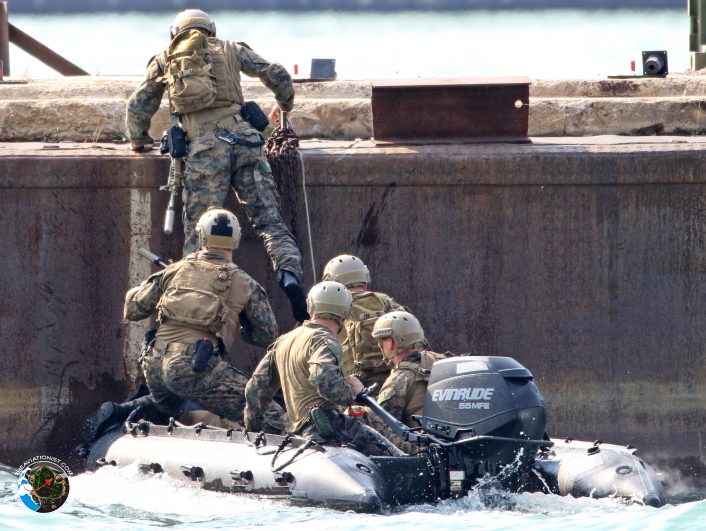
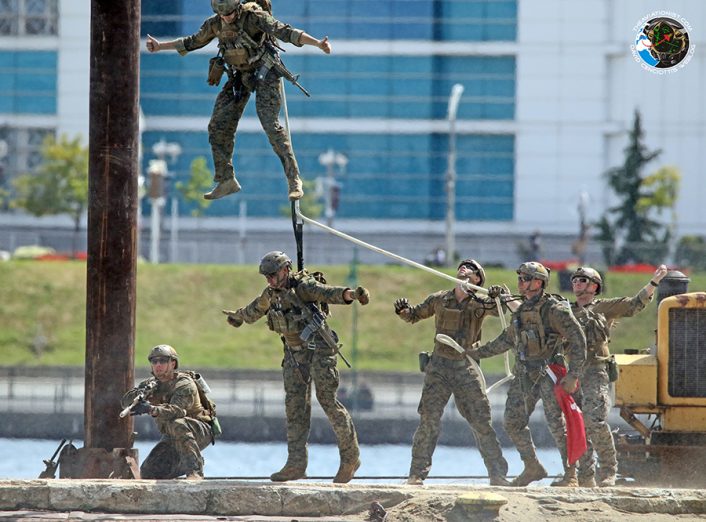
The famous 1st Reconnaissance Battalion won praise from now U.S. Secretary of Defense, former General James Mattis, when the unit was deployed to Helmand Province, Afghanistan in 2010. The unit performed a month-long insertion into the region, during which time they sustained no losses but were highly effective in routing insurgent forces and gained a reputation as fierce, effective combatants. One radio intercept between insurgent forces was quoted as saying, “We will not fight them, they are not normal Marines, they run at us when we shoot at them. If we fight them we die…”
The demonstration began with announcers providing background on a fictitious “ongoing intelligence operation” in the region. They had discovered a group of pirate/terrorists who stole the game ball from the local NFL Team, the Detroit Lions, that was to be used in their first game of the season. Without the precious ball, the game could not proceed as planned.
Marine intelligence assets tracked the mock terrorist/pirates who hijacked the game ball to a barge anchored in the Detroit River just inside the U.S/Canadian border. Once reconnaissance assets fixed the position of the perpetrators on the demonstration barge anchored in front of Detroit’s Renaissance Center they handed the intel over to a combined Marine Task Force for the recovery mission.
The first part of the demonstration in the Detroit River was a simulated artillery strike on the barge where the “pirates” were located. Following the mock artillery strike that featured a live “call for fire” radio transmission over the P.A. for spectators, two U.S. Marine F/A-18 Hornets of Marine Fighter Attack Squadron (All-Weather) 225 (VMFA(AW)-225) from Marine Corps Air Station (MCAS) Miramar, home of the famous “Top Gun” school, made a pass over the barge in the river while pyrotechnics were detonated on the barge to simulate an air strike. VMFA (AW)-225, the “Vikings” were the first Marine Air unit deployed to Operation Iraqi Freedom in 2003.
Following the simulated artillery and air strikes on the objective a Marine Special Operations boarding team from the 1st Reconnaissance Battalion used a pair of F470 Combat Rubber Raiding Craft (CRRC) with a five-man boarding team on each boat to assault the objective. The teams approached the simulated target barge from opposite sides of the vessel and made their boarding in only seconds.
During the small boat assault a pair of helicopters from Marine Light Attack Helicopter Squadron 267 (HMLA-267) based at Camp Pendleton, California flew up the Detroit River to perform a fast-rope insertion of additional Marine Recon special operators onto the target barge. The pair of helicopters included the newest version of the AH-1Z Viper attack helicopter based on the legacy Cobra attack helicopter and the UH-1Y Venom utility/attack helicopter based on the venerable “Huey” platform. The U.S. Marines are the only air arm in the U.S. military using these variants. The UH-1Y Venom helicopter wore a special paint livery for HMLA-267.
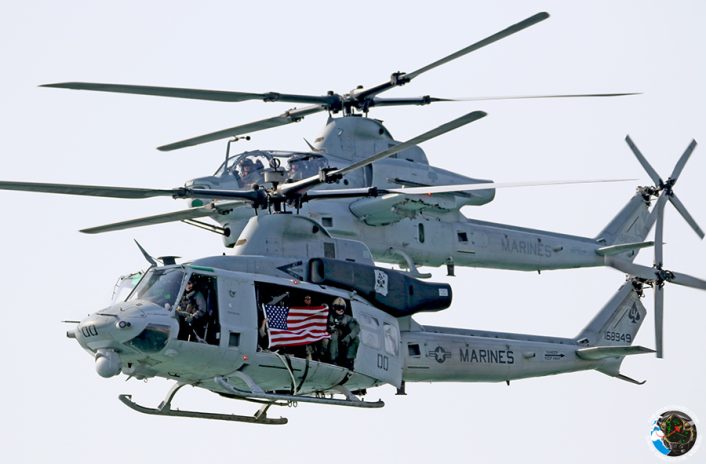
Among the Marine special operations team members who staged the mock assault on the barge were Sgt. Steven Echevaria and Sgt. Cody Cunningham from Twin Falls, Idaho. “This is what we do, thank you for having us here. It’s an honor to be able to come here and demonstrate our mission” Cunningham told us after the team returned to the Detroit Riverfront Walk to meet spectators following their assault demonstration.
Following the seaborne and air assault boarding of the simulated target the Marine Recon operators seized their objective, the football for use in the upcoming Detroit Lions football game, and began their extraction.
Prior to the extraction of the boarding team a pair of beautiful MV-22 Osprey tiltrotor aircraft from the famous Marine Medium Tiltrotor Squadron 166 (VMM-166) “Sea Elks” of Miramar Naval Air Station made a flyover while transitioning their proprotors from the vertical, hover orientation to the horizontal flight attitude as they accelerated away from show center.
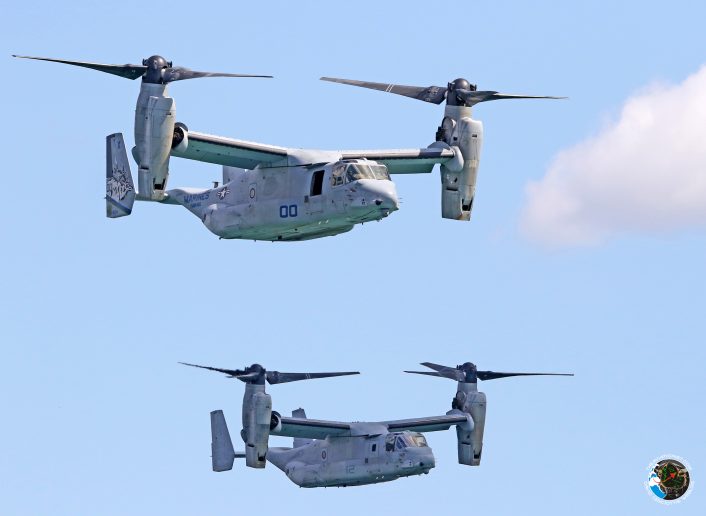
Another flyover featured the largest helicopter in U.S service, a CH-53E Super Stallion from Marine Heavy Helicopter Squadron 772 (HMH-772) the “Hustlers” from MacGuire AFB in New Jersey. Considering the age of the CH-53E Super Stallion this aircraft was in excellent condition and appeared to be meticulously maintained.
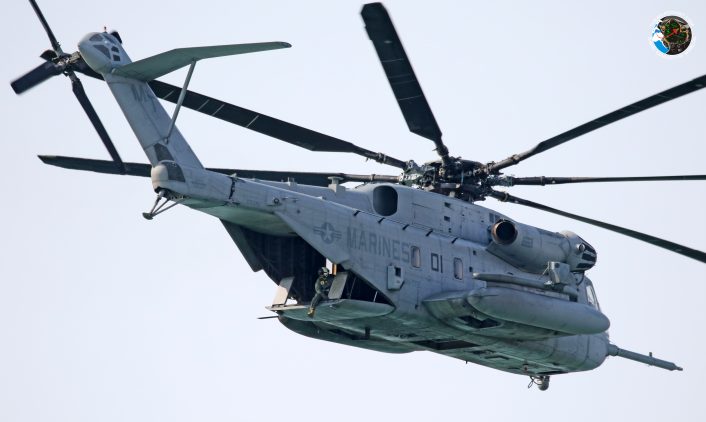
The final flyover featured two F/A-18 Hornets of Marine Fighter Attack Squadron (All-Weather) 225 (VMFA(AW)-225) and a KC-130J Hercules of Marine Aerial Refueler Transport Squadron 352 (VMGR-352), the “Raiders” from MCAS Miramar in California. The trio of aircraft flew in a simulated midair refueling formation over the show venue.
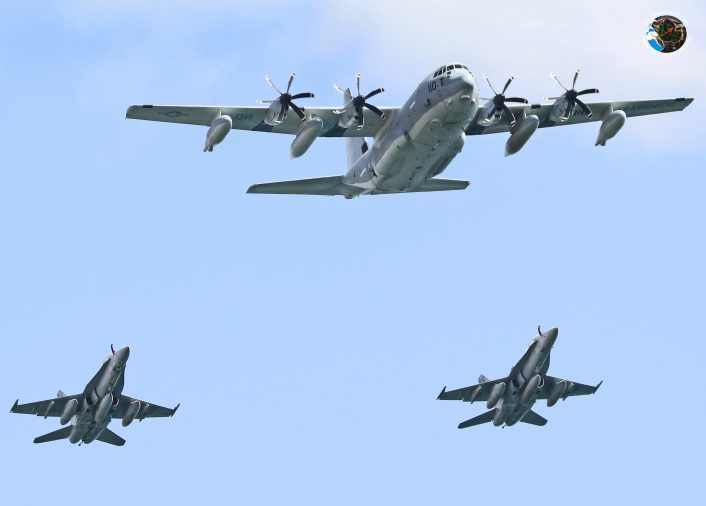
The Marine Week demos in Detroit were a unique new way to provide an up-close insight into U.S. Marine capabilities in a setting where they otherwise would not be exposed to them. It brings awareness of the Marine mission and showcases the Marines’ advances in equipment, tactics and capabilities while honoring the Marine legacy both nationally and locally. Much of the promotion of the event was done through social media along with broadcast media, an interesting insight into how the Marines have been progressive and effective with their media management and public relations mission.









